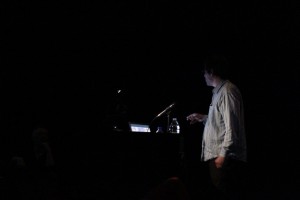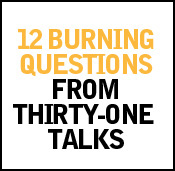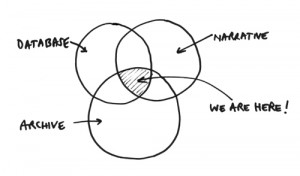 Florian Thalhofer, inventor of the Korsakow system, award-winning documentary filmmaker, and gracious Berliner, served up a fantastic keynote to close the first day of D|N|A. After making so many incredible K-films, including Planet Galata, 7Sons, Forgotten Flags, Korsakow Syndrom, and his very first non-linear film experiment, kleine Welt [Small World], his films are testament to his philosophy that “there is not just one truth–there are many.”
Florian Thalhofer, inventor of the Korsakow system, award-winning documentary filmmaker, and gracious Berliner, served up a fantastic keynote to close the first day of D|N|A. After making so many incredible K-films, including Planet Galata, 7Sons, Forgotten Flags, Korsakow Syndrom, and his very first non-linear film experiment, kleine Welt [Small World], his films are testament to his philosophy that “there is not just one truth–there are many.”
True to form, Florian’s keynote took an interactive format–creating a live version of the Korsakow method where the audience used laser pointers to collectively choose the next topic of discussion from preview visuals or SNUs (Smallest Narrative Units) on the screen. We learned that Korsakow films reflect human behavior–our strange penchant to make sense of things in the moment, like when Florian’s girlfriend told him that “he always looks taller after he showers”, when, in fact, he was wearing his new hiking boots along with his bath robe. “This is the basis for creativity”, Florian informs us, referring to our human capacity to reshuffle information and create all kinds of patterns, linear or not.
The first topic chosen by the group was The History of Korsakow, where Florian described its development back in 2000 when he was working on his diploma project at the University of the Arts in Berlin. After completing his first interactive, non-linear film, kleine Welt [Small World], Florian went on to make Korsakow Syndrom three years later and there have been over 40 Korsakow workshops around the world since. A chance meeting with Matt Soar in 2007 led to a collaboration (and great friendship) to further develop the Korsakow software, reprogramming it and relaunching a more user-friendly version in 2009.
Next, the group chose The Formats of Korsakow as the following narrative unit that Florian would present. More than a piece of software, Florian described Korsakow as a way of thinking. A system that can be used to structure all kinds of thinking. It is rule-based, but audience interaction determines how the film unfolds.
This is Your Brain marked the next SNU selected by D|N|A participants. Florian gave us his take on how the brain, thoughts, and feelings work. “Paths between brain cells are connected via synapses. Thoughts are lazy. They don’t like to walk too far on the path. They like to take shortcuts. If your thought is good, it will become used more often. When this happens, it creates meaningful connections of brain cells. Thoughts or feelings are an activation of a cloud of brain cells. A feeling contains a lot of thoughts. When we try to communicate a feeling from one thought to another, we make a cloud of brain cells.” …Reminds me of the “This is your brain. This is your brain on drugs” public service advert…”This is your brain. This is your brain on Korsakow”…
Next up, Florian launched into a discussion of SNUs and POCs (Points of Contact), and in- and out-keywords. These are the building blocks of a Korsakow-film and what workshoppers will learn when they get under the hood tonight and tomorrow in the labs. Florian explored a few other topics chosen by the audience, including Advice for all People (get a motorbike!), How the World Works (it’s a cloud of connection and communication), and the Work of a Scientist (like the Natural History Museum in Berlin, Korsakow helps you create a collection of things, categorize and label them).
Lastly, Florian presented insights into his most recent film, Planet Galata, both a linear version for ARTE and a Korsakow-film about Istanbul’s iconic flat bridge across the Bosporus. He discussed his challenge to make a linear narrative and to find a climax to the plot, inventing a fairy tale of a dragon that devoured people crossing the Golden Horn as a method to bring a high point of drama to the film. Florian candidly commented that “to work on a linear film for first time in life was an amazing experience. It forces the author to put an order to things, claiming to be the right order, superior to all others. I had to get rid of characters that would fit in a Korsakow-film. We had to find an inner logic to the sequencing and ordering to the film. Sometimes I had to use an order I did not believe in. I had to use my opinions as glue to the film. We see different characters and had to make choices about sequencing.” He’s not yet satisfied with the K-film version and said it feels “like it’s not finished yet”.
Thanks, Florian, for a lively talk. We left inspired, amused, and eager to get working on our Korsakow-film!





Comments on this entry are closed.